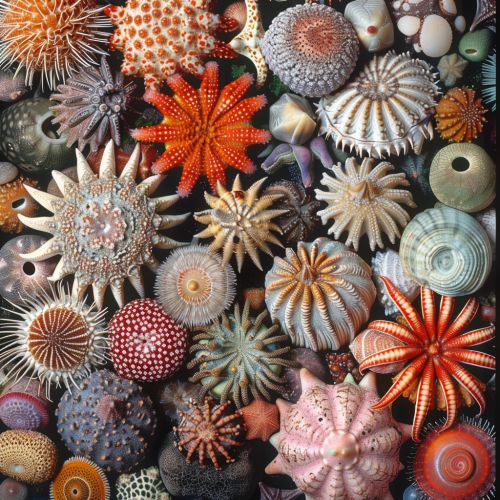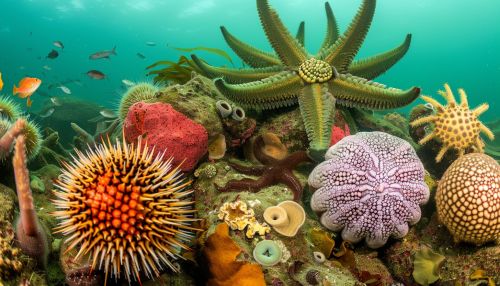Echinodermata
Introduction
The Echinodermata are a phylum of marine animals found in nearly every ocean environment. The name "Echinodermata" derives from the Greek words "echinos," meaning "hedgehog," and "derma," meaning "skin," a reference to the spiny skin that is a characteristic feature of this group. Echinoderms are known for their radial symmetry, a trait that distinguishes them from most other animal phyla and is most evident in the sea stars and sea urchins. The phylum includes about 7,000 living species, making it one of the largest phyla in the animal kingdom.


Classification
Echinodermata is divided into five extant classes: Asteroidea (sea stars or starfish), Ophiuroidea (brittle stars), Echinoidea (sea urchins and sand dollars), Crinoidea (sea lilies and feather stars), and Holothuroidea (sea cucumbers). Each class is distinguished by unique morphological and physiological characteristics.
Asteroidea
The Asteroidea class is perhaps the most recognizable, encompassing the sea stars or starfish. They are characterized by their star-shaped body, which typically has five arms, although some species have more.
Ophiuroidea
The Ophiuroidea class includes the brittle stars and basket stars. They are closely related to the sea stars but are distinguished by their long, slender, and highly flexible arms, which they use for locomotion.
Echinoidea
The Echinoidea class includes sea urchins and sand dollars. They are characterized by their globular or disc-shaped body covered with spines, which they use for protection and locomotion.
Crinoidea
The Crinoidea class includes the sea lilies and feather stars. They are the most ancient class of echinoderms, with fossil records dating back to the Ordovician period.
Holothuroidea
The Holothuroidea class includes the sea cucumbers. They are characterized by their elongated, soft-bodied form, a departure from the typical hard, calcified bodies of other echinoderms.
Anatomy and Physiology
Echinoderms are known for their unique anatomical and physiological features, including a water vascular system, radial symmetry, and an endoskeleton made of calcified plates.
Water Vascular System
The water vascular system is a network of fluid-filled canals and appendages that function in locomotion, feeding, waste removal, and respiration. It is a unique feature of echinoderms and is central to their biology.
Radial Symmetry
Echinoderms exhibit radial symmetry, a form of symmetry in which body parts are arranged around a central axis. This is a departure from the bilateral symmetry seen in most other animal phyla and allows echinoderms to interact with their environment in all directions.
Endoskeleton
Echinoderms possess an endoskeleton made of calcified plates, which provides support and protection. The endoskeleton is covered by a thin layer of skin and in some species, is adorned with spines or other protrusions.
Reproduction and Development
Echinoderms reproduce both sexually and asexually. Sexual reproduction involves the release of eggs and sperm into the water, where fertilization occurs. The resulting larvae undergo a series of developmental stages before metamorphosing into the adult form. Some echinoderms can also reproduce asexually through a process known as regeneration, in which a new individual grows from a fragment of the parent.
Ecology
Echinoderms play important roles in marine ecosystems. They are often major contributors to the biodiversity of their habitats and play key roles in nutrient cycling and habitat structure. Some species are also important prey for other marine animals, while others are predators of small invertebrates.
Evolution
The echinoderms have a rich fossil record that dates back to the Cambrian period, over 500 million years ago. They have undergone significant evolutionary changes over this time, with many extinct groups and several major radiations.
